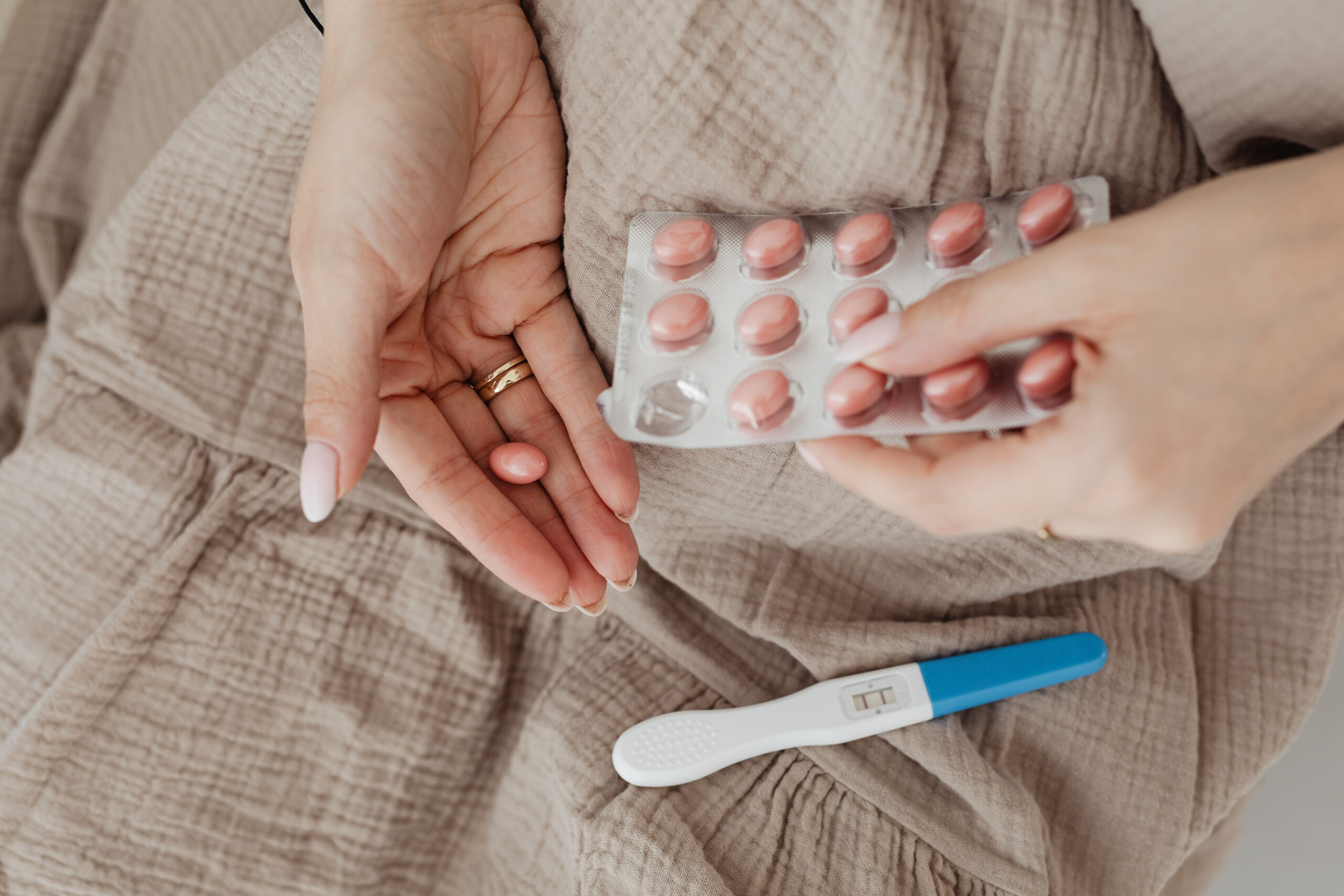What Are Environmental Toxins and Endocrine Disruptors?
Endocrine disrupting chemicals (EDCs) are harmful substances found in everyday environments like air, water, household products, clothing and cosmetics that can interfere with normal hormonal function.
Common Sources of Endocrine Disruptors:
- Plastics: Containing BPA and phthalates.
- Non-stick cookware & rain resistant clothing: contain forever chemicals like PFAS, PFOA & PTFE.
- Cosmetics and Personal Care Products: many include synthetic fragrances, parabens, and phthalates.
- Perfumes and Fragranced Candles: these are particularly high in synthetic chemicals.
- Household Cleaners: products with “unscented” labels can still contain fragrance additives.
The Impact of Environmental Toxins on Hormones & Fertility
Hormones are crucial for regulating your mood, energy, fertility, and overall health. However, these delicate systems can be disrupted by environmental toxins, particularly those found in everyday items like perfumes, fragranced candles, and cosmetics. The most sensitive window of exposure to endocrine disrupting chemicals is during critical periods of development, such as during the first 12 weeks of gestation and during puberty.1
Close to 800 chemicals are known or suspected to be capable of interfering with hormone receptors, hormone synthesis or hormone conversion. However, the majority of chemicals used in commercial production have never been tested at all.1
How Do EDCs Disrupt Hormones?
- Mimicking Hormones
Many synthetic fragrances contain phthalates, which mimic oestrogen in the body, leading to hormonal imbalance, menstrual irregularities, heightened menopause symptoms. - Blocking Hormone Receptors
Because phthalates mimic oestrogen, they are able to bind to oestrogen receptors and interfere with communication between your hormones and the cells they regulate. - Overloading Detox Pathways
Synthetic fragrances add to your body’s toxic load, overwhelming detoxification pathways in the liver, where hormones are also processed. This can impair oestrogen metabolism, especially in people with genetic mutations leading to impaired hormonal clearance (e.g. COMT, UGT) and can lead to hormonal imbalances and cancers.
What Are the Health Impacts of Endocrine Disrupting Chemicals?
Chronic exposure to endocrine disruptors can contribute to:
- Hormonal Conditions: PCOS, Endometriosis, Breast Cancer, early puberty & Prostate Cancer.
- Infertility: by impairing ovulation, sperm quality, and are associated with causing undescended testes in male babies.
- Nervous System: increasing the risk of Parkinson’s Disease, Alzheimer’s, Dementia, ADHD & Autism.
- Metabolism: insulin resistance, obesity, Type 2 Diabetes, PCOS & Gestational Diabetes
- Thyroid Disorders: Hypothyroidism, Grave’s Disease, Hashimoto’s & Thyroid Cancer.3 4
The Unique Problem with Fragrances
Perfumes and Fragranced Products
Fragrance can be made up of a mix of any of more than 3,500 chemicals and gives most personal care, household cleaning and other commercial products their unique smell. They often include:
- Phthalates: used to stabilise fragrance and make it last longer. These are known to mimic oestrogen and have been linked to fertility issues.
- Styrene: is another synthetic fragrance linked to cancer.
- Volatile Organic Compounds (VOCs): Released into the air when candles burn or through aerosol sprays can disrupt endocrine function and affect respiratory health5.
Practical Steps to Reduce Toxin Exposure
Clean up your Cosmetic and Household Cleaning Products:
- Choose cosmetic and household cleaning products labeled “phthalate-free” and “paraben-free.”
- Avoid products with vague terms like “fragrance” or “parfum” on labels. Look for unscented or essential oil-based alternatives for perfumes, skincare, and household products.
- Avoid anything that has an aerosol spray to minimise VOC exposure.
- Check your cosmetics using the EWG Skin Deep database, and aim for products with a rating lower than 5.
2. Opt for Clean Candles
- Replace fragranced candles with options made from beeswax or soy wax, scented only with essential oils.
- Ensure proper ventilation when burning any candle to reduce VOC exposure, or opt for a steam diffuser with essential oils.
3. Choose Clean Cookware
- Avoid non-stick cookware, or look for non-stick cookware that is free of PTFE, PFOA or PFAS.
- Instead cook with cast iron, enamel and stainless steel.
4. Improve Indoor Air Quality
- Keep windows open as much as possible to ventilate your home.
- Use indoor plants, which naturally purify the air.
- Use air purifiers to reduce indoor toxins from fragrances and other pollutants.
5. Minimise Plastic Use
- Avoid storing food in plastic containers or drinking from plastic bottles, as these can also leach BPA and micro-plastics into your food. Instead store and heat food in glass containers.
- Avoid using takeaway coffee cups, instead purchase and use a glass or stainless steel keep cup.
Signs Environmental Toxins May Be Affecting Your Hormones
Symptoms that may indicate toxin exposure is disrupting your hormones include:
- Irregular or painful periods
- Unexplained infertility or recurrent miscarriage
- Fatigue and brain fog
- Unexplained weight gain or difficulty losing weight
- Chronic skin issues like acne or eczema
Brands that I love and use regularly:
- Candles: IKOU & Wildfolk
- Skincare: MAAEMO, Mukti, IKOU & Edible Beauty
- Suncream: Mother SPF, Avocado Zinc & Wotnot Naturals
- Nail polish: Sienna
- Makeup: INIKA & Bare Essentials
- Haircare: Aveda
- Cookware: Our Place pans & Solid Teknics
- Household cleaning: Koala Eco & Eco Store
Other Great Resources:
- Follow @jordiepieface on instagram. She is a Nutritionist and absolute guru on identifying dangerous ingredients in products. She regularly posts on the best and worst product categories, which are a great resource to refer back to when purchasing products.
- Check your cosmetics using the EWG Skin Deep database, and aim for products with a rating lower than 4. They will also generate an extensive report on the research regarding health risks for each product ingredient.
- Download the EWG Health Living app to scan a product and assess the ingredients.
- Bergman, Å., Heindel, J., Jobling, S., Kidd, K., & Thomas Zoeller, R. (n.d.). State of the Science of Endocrine Disrupting Chemicals 2012 Summary for Decision-Makers. World Health Organisation. https://iris.who.int/bitstream/handle/10665/78102/WHO_HSE_PHE_IHE_2013.1_eng.pdf?sequence=1
↩︎ - Bergman, Å., Heindel, J., Jobling, S., Kidd, K., & Thomas Zoeller, R. (n.d.). State of the Science of Endocrine Disrupting Chemicals 2012 Summary for Decision-Makers. World Health Organisation. https://iris.who.int/bitstream/handle/10665/78102/WHO_HSE_PHE_IHE_2013.1_eng.pdf?sequence=1
↩︎ - Ahn, C., & Jeung, E. B. (2023). Endocrine-Disrupting Chemicals and Disease Endpoints. International journal of molecular sciences, 24(6), 5342. https://doi.org/10.3390/ijms240653423 ↩︎
- Yilmaz, B., Terekeci, H., Sandal, S., & Kelestimur, F. (2020). Endocrine disrupting chemicals: exposure, effects on human health, mechanism of action, models for testing and strategies for prevention. Reviews in endocrine & metabolic disorders, 21(1), 127–147. https://doi.org/10.1007/s11154-019-09521-z ↩︎
- McDonald, B. C., de Gouw, J. A., Gilman, J. B., Jathar, S. H., Akherati, A., Cappa, C. D., Jimenez, J. L., Lee-Taylor, J., Hayes, P. L., McKeen, S. A., Cui, Y. Y., Kim, S.-W., Gentner, D. R., Isaacman-VanWertz, G., Goldstein, A. H., Harley, R. A., Frost, G. J., Roberts, J. M., Ryerson, T. B., & Trainer, M. (2018). Volatile chemical products emerging as largest petrochemical source of urban organic emissions. Science, 359(6377), 760–764. https://doi.org/10.1126/science.aaq0524 ↩︎




Comments +